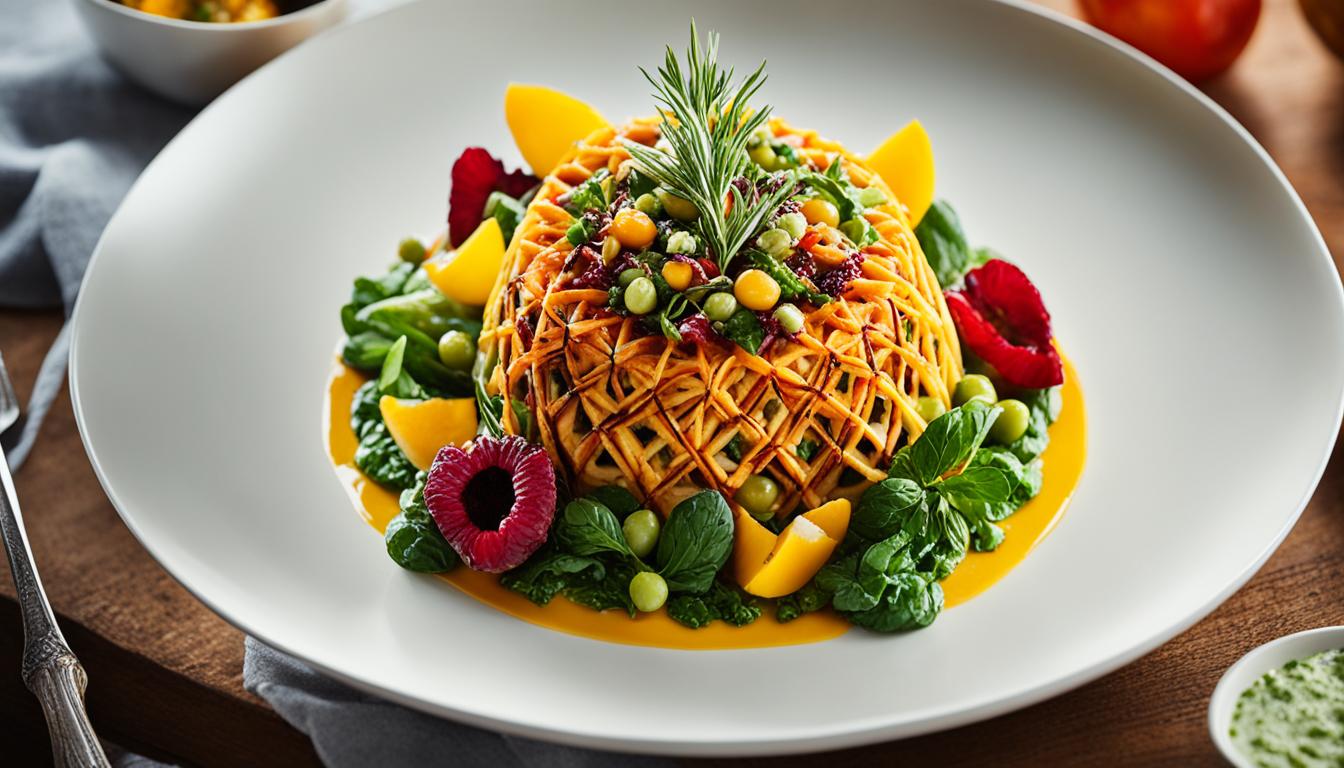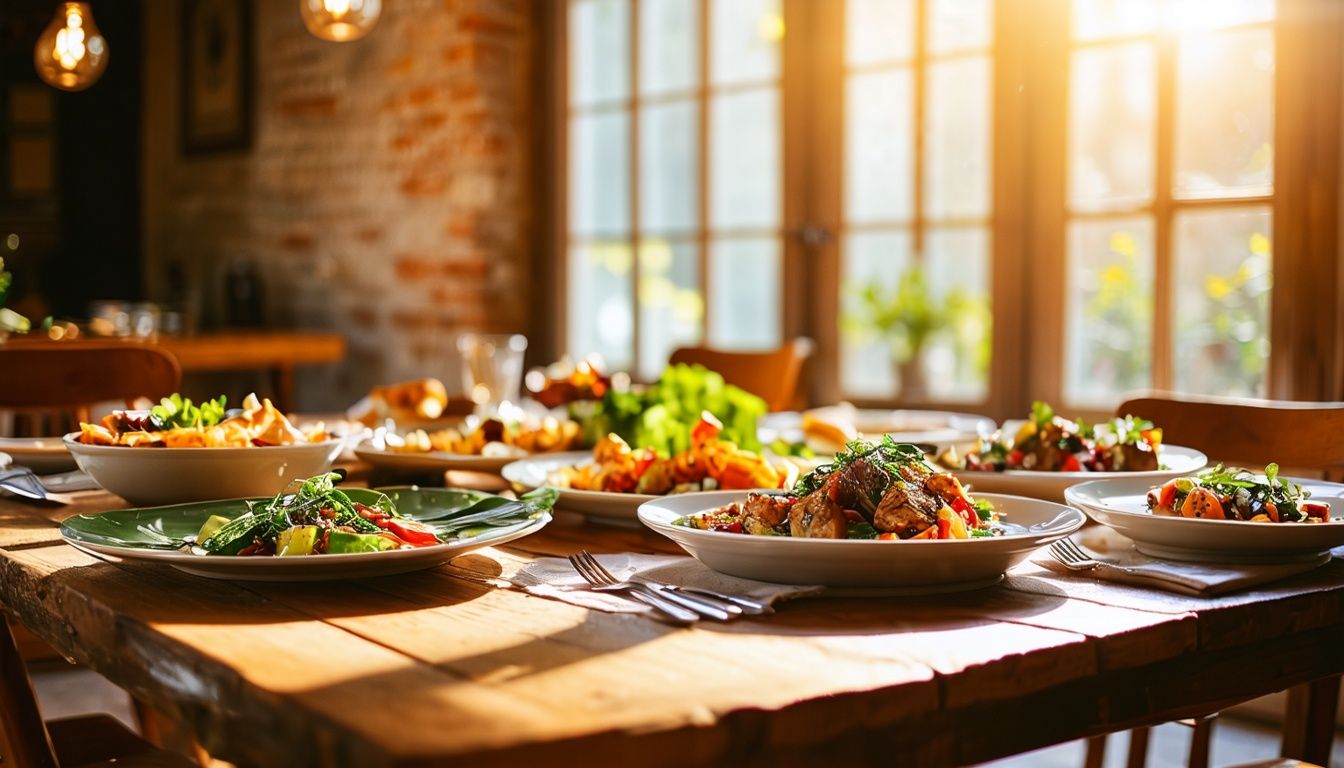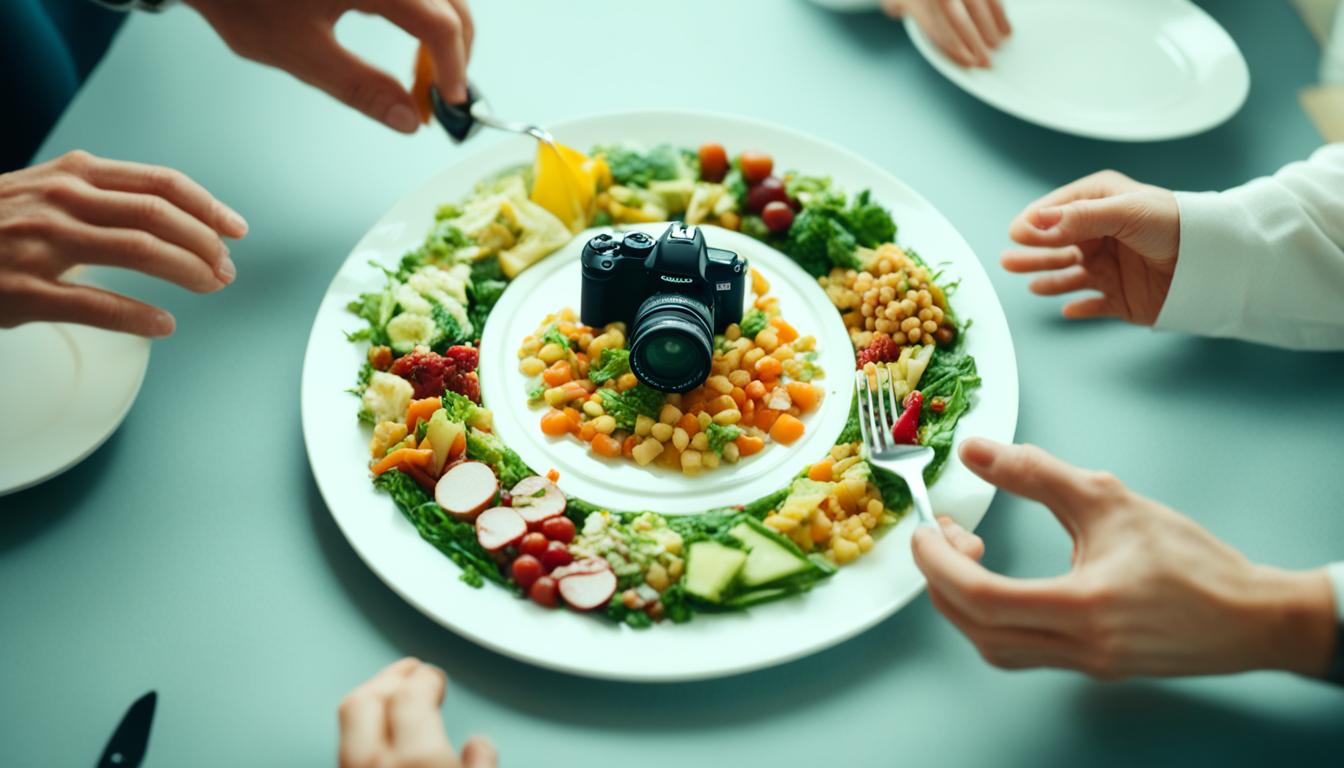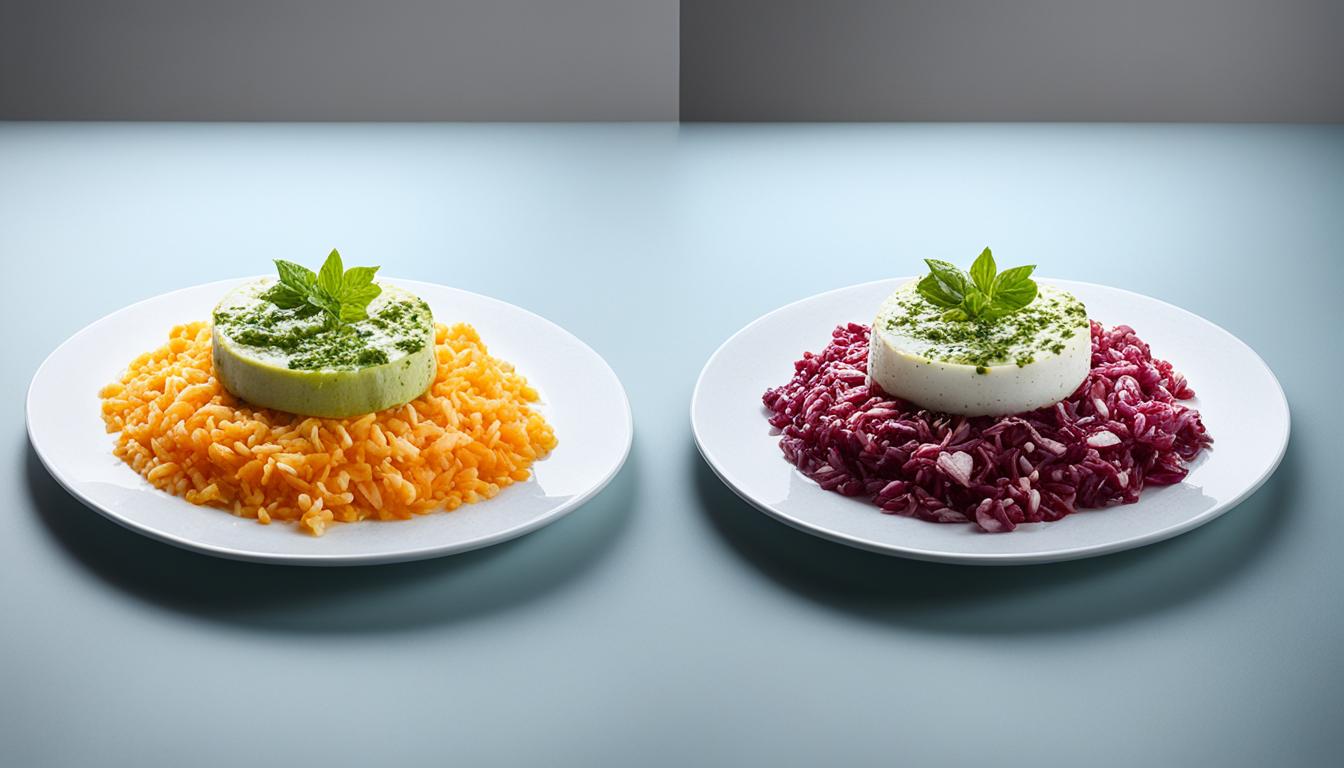Food photography is a powerful tool for capturing the beauty and artistry of dishes. It tells a visual story and allows us to showcase our skills as chefs and culinary professionals. By mastering the art of food styling, we can enhance our food photography and create stunning, photogenic images. In this guide, we provide actionable advice and insights to help you take your food styling to the next level.
Key Takeaways:
- Learn to enhance your food photography by mastering the art of food styling.
- Food photography plays a crucial role in showcasing the expertise and creativity of chefs.
- Choose the right camera equipment and props to capture stunning food shots.
- Understanding lighting techniques can elevate the visual appeal of your food photos.
- Experiment with composition techniques to create visually captivating images of your dishes.
Importance of Food Photography in the Culinary World
Food photography is more than just capturing visually pleasing dishes; it is a form of storytelling that showcases the expertise and creativity of chefs. Through the lens, we can bring to life the aesthetics in food styling, capturing textures, colors, and intricate details that draw viewers into the culinary experience.
Professional food styling techniques play a crucial role in food photography, enabling chefs to present their creations in the most visually appealing way. These techniques involve arranging and presenting food in a manner that enhances its natural beauty and highlights its unique features. By utilizing food photography tricks, such as strategic placement of ingredients and props, controlling angles and lighting, and emphasizing key elements, chefs can create captivating images that entice viewers and leave a lasting impression.
“Food photography is more than just capturing visually pleasing dishes; it is a form of storytelling that showcases the expertise and creativity of chefs.”
Food photography serves multiple purposes in the culinary world. It acts as a powerful marketing tool, attracting customers to restaurants and elevating their dining experience. By capturing the essence of dishes through aesthetically pleasing images, professional food styling and photography contribute to an inviting and enticing culinary brand.
Restaurants can also benefit from establishing a consistent visual identity through their food photography. By maintaining a recognizable style, color palette, and overall aesthetic, they can create a cohesive brand image that resonates with their target audience and helps differentiate themselves from the competition.
Moreover, professional food styling and photography have become increasingly relevant in the digital age, especially with the rise of social media platforms such as Instagram. Chefs and restaurants are now expected to not only create delicious dishes but also present them in a visually appealing way. Mastering the art of food photography allows chefs to showcase their culinary skills and creations to a larger audience, ultimately boosting their online presence and generating interest and excitement around their offerings.
Essential Camera Equipment for Food Photography
In order to capture stunning food shots and bring out the best in your culinary creations, it is crucial to have the right camera equipment. Here are some essential tools that will elevate your food photography to the next level:
1. Camera
When it comes to cameras, both DSLR (Digital Single-Lens Reflex) and mirrorless cameras are popular choices among food photographers. These cameras offer excellent image quality, versatility, and the ability to capture high-resolution photos and videos. Investing in a good camera will allow you to capture the intricate details and colors of your dishes with exceptional clarity.
2. Prime Lenses
Prime lenses are highly recommended for food photography due to their wide aperture and sharp image quality. These lenses allow for better control over depth of field, enabling you to achieve that beautiful blurred background effect while keeping the main subject in sharp focus. Popular focal lengths for food photography include 50mm and 85mm.
3. Tripod
A sturdy tripod is an indispensable tool for food photography. It provides stability, ensuring that your camera is perfectly still and eliminating any camera shake. This is especially important when shooting in low-light conditions or when using longer shutter speeds. Consider investing in a tripod with a 360° rotating ‘ball’ head or a pan-tilt head, which allows for easy adjustments and capturing various angles and compositions.
4. Props
In addition to camera equipment, props can greatly enhance the visual appeal of your food. Consider incorporating neutral backgrounds, such as marble or wooden surfaces, to create a clean and sophisticated look. Textured fabrics, such as linen or burlap, can add depth and visual interest. Wooden accents, such as cutting boards or rustic utensils, can bring warmth and a natural element to your compositions.

By utilizing these essential camera tools and prop ideas, you’ll be better equipped to capture the beauty and artistry of your dishes. The next section will dive into the important role lighting plays in food photography.
Understanding Lighting in Food Photography
Lighting is a key element in food photography. It has the power to transform an ordinary dish into a visually captivating masterpiece. Whether you’re styling food for Instagram or capturing images for a professional food blog, understanding how to manipulate and control light can make all the difference in creating stunning and appealing food photos.
One of the most beautiful and flattering sources of light for food photography is natural light. The golden hours of the day, early morning or late afternoon, provide a soft and warm glow that enhances the texture and shape of the food. This natural light brings out the vibrant colors and highlights the intricate details of the dish. It creates a welcoming and appetizing atmosphere that draws viewers in.
However, there may be situations where natural light is not available or needs to be controlled. In such cases, artificial lighting can be a useful tool for capturing stunning food images. With the right equipment and techniques, you can mimic the softness and warmth of natural light, even in a controlled indoor environment.
Artificial Lighting Techniques
When using artificial lighting, it’s important to choose the right light source and modify it to achieve the desired effect. Continuous lighting, such as LED panels or softboxes, can provide a consistent and even illumination across the scene. These lights are ideal for creating beautifully lit food photos with minimal shadows.
On the other hand, if you prefer a more dramatic look with pronounced shadows and highlights, you can experiment with strobe lighting. Strobe lights, like studio flash units, allow you to freeze the motion of the food and create stunning images with a high level of control. They add depth and dimension to your photos, emphasizing the textures and shapes of the dish.
Regardless of whether you’re using natural or artificial lighting, it’s crucial to understand how light interacts with different surfaces and textures. Reflectors and diffusers can help you manipulate and control light, reducing harsh shadows and creating a softer, more flattering illumination. These tools are especially useful when photographing glossy or reflective surfaces, such as glassware or metallic utensils.
“Lighting is the paintbrush of food photography. It sets the mood, highlights the details, and brings the dish to life.”
Experimenting with different lighting setups, angles, and intensities will help you develop your own unique style when it comes to food photography. Don’t be afraid to play with shadows, highlights, and color temperatures to create captivating and visually appealing images that make your audience crave the dishes you showcase.
Tips for Styling Food for Instagram
When styling food specifically for Instagram, keep in mind that the platform is visual-centric and favors bright, clean images that evoke a sense of freshness and appetite appeal. Here are a few tips to make your food photos stand out:
- Choose a cohesive theme: Create a consistent visual style by using similar props, backgrounds, or color palettes. This will make your Instagram feed more aesthetically pleasing and cohesive.
- Highlight the hero: Showcase the hero of the dish by styling it front and center. Make it the focus of the composition and use props sparingly to enhance, but not overpower, the main subject.
- Utilize negative space: Leave empty areas in your composition to create a sense of balance and draw attention to the food. Negative space allows the viewer’s eyes to rest and appreciate the details of the dish.
- Play with textures and layers: Incorporate various textures and layers to add depth and interest to your photos. This could include sprinkling herbs, drizzling sauces, or arranging garnishes in an appealing way.
- Consider different angles: Experiment with different angles to find the most flattering perspective for the food you’re photographing. Overhead shots, 45-degree angles, and close-ups are popular choices for capturing the beauty and details of the dish.
Remember, practice and experimentation are key to mastering the art of food styling and photography. Embrace your creativity, follow these tips, and continuously refine your skills to capture stunning and captivating food photos that will leave your audience hungry for more.
Composition Techniques for Captivating Food Photos
In the world of food photography, composition is a crucial element in creating visually appealing and captivating images. By mastering professional food styling and understanding the art of food presentation, you can expertly showcase the beauty and details of your dishes. In this section, we will explore composition techniques that will elevate your food photos to the next level.
Framing and Angles
When composing your food photos, consider using framing and angles to enhance the overall composition. Framing the food with complementary ingredients or elements within the scene adds depth and focus to your image. This technique can draw the viewer’s attention to the main subject and create a visually pleasing composition.
Experiment with different angles to showcase the details and beauty of your dish. Overhead shots provide a unique perspective and allow you to capture the entire plate, while 45-degree angles highlight the textures and layers of the food. Close-up shots bring the viewer closer to the dish, highlighting its intricate details and enticing visual appeal.
Negative Space
Don’t overlook the power of negative space in your food photography composition. Negative space refers to the empty areas surrounding the main subject. By intentionally leaving space around your dish, you can create a visually appealing composition that draws attention to the food and adds a sense of balance and elegance to the image.
Incorporating Color and Texture
Color and texture play significant roles in food photography composition. Experiment with different color palettes to create harmonious and visually captivating images. Consider using complementary colors to make your dishes stand out, or monochromatic tones for an elegant and sophisticated look.
Texture adds depth and interest to your photos. Showcase the textures of ingredients, such as the crispiness of lettuce or the smoothness of chocolate. Use props like textured fabric or rustic backgrounds to enhance the visual appeal of your images.

By mastering these composition techniques and combining them with professional food styling, you can create captivating food photos that engage and inspire your audience. Remember to experiment, find your unique style, and let your creativity shine through each composition.
Conclusion
Mastering the art of food styling is the key to creating stunning and photogenic dishes that capture the attention of your audience. By understanding the importance of food photography and implementing effective techniques, you can take your food presentation to the next level.
Having the right camera equipment, such as a DSLR or a mirrorless camera with prime lenses, allows you to capture high-quality images that showcase the details and beauty of your culinary creations. Manipulating lighting, whether it’s natural or artificial, helps enhance the texture and shape of the food, creating visually appealing photos.
In addition, composition techniques play a crucial role in creating captivating food photos. Framing the food, choosing different angles, and incorporating negative space and textures all contribute to an aesthetically pleasing composition. Don’t be afraid to experiment with styling tips, props, and post-processing techniques to further elevate the visual appeal of your images.
Building a strong food photography portfolio and showcasing your unique style can attract potential clients and collaborations, opening doors for exciting opportunities. Remember, mastering the art of food presentation is a continuous journey of practice, creativity, and honing your skills. With dedication, you can become a master of the art of food styling.
FAQ
What is food styling and why is it important?
Food styling is the art of arranging and presenting food in an aesthetically pleasing manner. It is important because it enhances the visual appeal of dishes, making them more photogenic and enticing to viewers.
How does food photography add value to the culinary world?
Food photography goes beyond capturing visually pleasing dishes. It serves as a form of storytelling that showcases the expertise and creativity of chefs, effectively boosting sales and elevating the dining experience.
What camera equipment is essential for food photography?
Essential camera equipment for food photography includes a DSLR or mirrorless camera for image quality, prime lenses for sharper images, and a tripod for stability. Props such as neutral backgrounds and textured fabrics can also enhance the visual appeal of the food.
How does lighting affect food photography?
Lighting is a key element in food photography. Natural light during the golden hours of the day provides a soft and warm glow, while artificial lighting can be used to create stunning images. Proper manipulation and control of light enhance the texture and shape of the food.
What composition techniques should I use for captivating food photos?
Framing and angles are important composition techniques. Framing the food with ingredients or using elements within the scene creates depth and focus. Different angles, such as overhead shots and close-ups, showcase the details and beauty of the dish. Negative space, color, and texture add depth and interest to the images.
How can I master the art of food styling and enhance my food photography?
Mastering the art of food styling involves understanding the importance of food photography, having the right camera equipment, manipulating lighting, and using composition techniques. Experimenting with styling tips, props, and post-processing techniques further enhances the visual appeal of the images.
How Can Food Styling Techniques Enhance the Photography of Different Types of Dishes?
Mastering food photography desserts can be greatly enhanced with effective food styling techniques. Whether it’s emphasizing the textures of a chocolate lava cake or adding garnishes to a colorful salad, careful styling can make main courses and desserts look even more tempting and irresistible in photographs.
Source Links
- https://www.limepack.eu/blog/mastering-the-art-of-food-photography-tips-tricks-and-techniques-for-stunning-images
- https://www.photoed.ca/post/julia-konovalova-s-ultimate-guide-to-food-styling
- https://lcbonline.medium.com/capturing-food-creating-art-10-ways-to-up-your-food-photography-skills-bf83a4302f44




